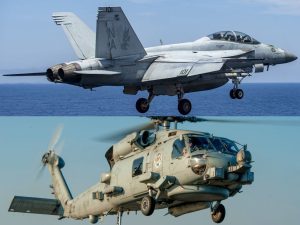Washington D.C. – The United States Navy experienced two separate US Navy crashes on Saturday when both a helicopter and a fighter jet went down in the South China Sea during what military officials described as routine operations. The incidents, occurring just 30 minutes apart, raised immediate concerns about operational safety, though all personnel involved were successfully recovered and reported to be in stable condition.
These US Navy crashes represent a significant operational setback for American naval forces operating in one of the world’s most strategically important maritime regions, where tensions frequently run high due to competing territorial claims and military presence.
First Incident: MH-60R Sea Hawk Helicopter Goes Down
The first of the US Navy crashes involved an MH-60R Sea Hawk helicopter assigned to the “Battle Cats” of Helicopter Maritime Strike Squadron (HSM) 73. According to an official Navy statement, the incident occurred at approximately 2:45 PM local time on October 26, 2025, while the aircraft was conducting routine operations from the aircraft carrier USS Nimitz (CVN 68).
The helicopter went down in South China Sea waters, prompting an immediate response from search and rescue assets assigned to Carrier Strike Group 11. In what represented a successful rescue operation, all three crew members aboard the helicopter were safely recovered from the water. The swift response demonstrated the Navy’s preparedness for such emergencies, even as investigators began examining the circumstances that led to these US Navy crashes.
The MH-60R Sea Hawk is a sophisticated multi-mission helicopter designed for anti-submarine warfare, anti-surface warfare, search and rescue, combat search and rescue, vertical replenishment, and naval gunfire support. Its loss represents a significant equipment setback for the carrier strike group’s operational capabilities.
Second Incident: F/A-18F Super Hornet Fighter Jet Crashes
Merely 30 minutes after the helicopter incident, the second of the US Navy crashes occurred when a Boeing F/A-18F Super Hornet fighter jet went down in the same waters. The aircraft was also conducting routine operations from the USS Nimitz when the incident took place.
According to official Navy statements regarding these US Navy crashes, both crew members aboard the fighter jet successfully ejected from the aircraft before impact. The two aviators were subsequently recovered safely from the South China Sea and reported to be in stable condition, marking another successful rescue operation despite the loss of valuable military hardware.
The F/A-18F Super Hornet is a twin-engine, carrier-capable multirole fighter aircraft that serves as a cornerstone of US naval aviation. The loss of such an advanced aircraft in these US Navy crashes represents a substantial financial and operational impact for the Navy’s Pacific operations.
Investigation and Safety Protocols

Following these US Navy crashes, military officials confirmed that the causes of both incidents are currently under thorough investigation. The Navy statement emphasized that “all personnel involved are safe and in stable condition,” while investigators work to determine what factors contributed to both aircraft going down within such a short timeframe.
The proximity of these US Navy crashes—both in time and location—will likely prompt investigators to examine whether any common factors, such as weather conditions, operational tempo, or other environmental elements, may have played a role in both incidents. The fact that both aircraft were operating from the same carrier, USS Nimitz, will also be a focal point of the investigation.
Also Read: Jaishankar-Rubio Meeting: Critical Breakthrough in India-US Relations During ASEAN Summit 2025
Strategic Timing and Political Context
The timing of these US Navy crashes carries additional significance as they occurred during President Donald Trump’s first Asia tour and just ahead of Defence Secretary Pete Hegseth’s planned multi-country Asia tour. The incidents highlight the operational risks faced by American military personnel deployed in the region, even during routine operations.
The South China Sea remains one of the most contested maritime regions globally, with multiple nations asserting territorial claims and maintaining significant military presence. These US Navy crashes occurred in waters where the United States regularly conducts freedom of navigation operations to challenge what it views as excessive maritime claims.
Pattern of Recent Naval Aviation Incidents
These US Navy crashes are not isolated occurrences but part of a concerning pattern of naval aviation accidents. Earlier in 2025, two US warplanes fell off the Navy’s Harry S. Truman aircraft carrier while operating in the Middle East, raising questions about operational safety across the fleet.
In May 2025, an F/A-18F Super Hornet crashed while attempting to land on the Truman’s flight deck when the landing manoeuvre failed, “causing the aircraft to go overboard,” according to officials. This incident followed another Super Hornet that similarly failed its landing manoeuvre and went overboard, suggesting potential systemic issues that may require broader examination.
Operational Implications
The US Navy crashes underscore the inherent dangers of naval aviation operations, particularly those conducted from aircraft carriers in challenging maritime environments. Despite advanced technology and extensive training, carrier operations remain among the most demanding and dangerous missions in military aviation.
As investigations into these US Navy crashes continue, the incidents serve as a reminder of the risks undertaken by naval aviators and the importance of maintaining the highest safety standards while conducting operations in strategically vital regions like the South China Sea.

